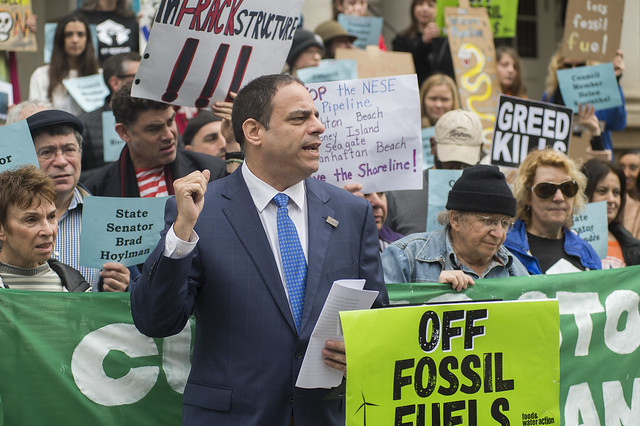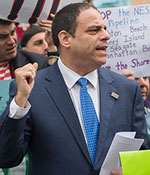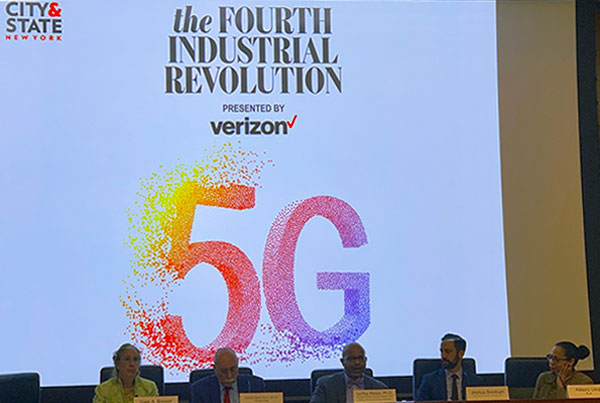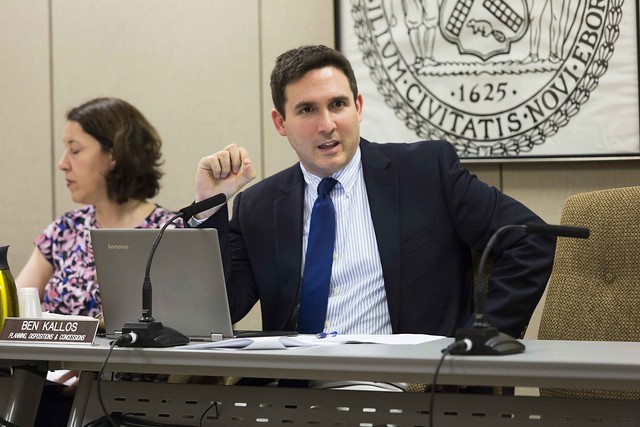Max & Murphy Podcast: The City Council Takes on Climate Change

Council Member Constantinides (photo: Jeff Reed/City Council)
April 17, 2019 - Max & Murphy Podcast: The City Council Takes on Climate Change
 City Council Member Costa Constantinides joined the show to discuss a package of legislation he's shepherding through the City Council that aim to fight climate change, including by major requirements for reducing building carbon emissions, as well as his vision for the future of Rikers Island, and more.
City Council Member Costa Constantinides joined the show to discuss a package of legislation he's shepherding through the City Council that aim to fight climate change, including by major requirements for reducing building carbon emissions, as well as his vision for the future of Rikers Island, and more.
Listen to the conversation and let us know what you think -- we're on Twitter @TweetBenMax and @JarrettMurphy. You can listen to the show through the embedded audio below or download the episode wherever you get your podcasts, under "Max & Murphy," and listen to Max & Murphy live on Wednesdays at 5 p.m. on WBAI radio, 99.5FM or wbai.org
***
by Ben Max, Gotham Gazette
@tweetBenMax @GothamGazette
Super-Fast 5G is Coming to the Five Boroughs, But City Officials Aren’t Sure When

(photo: Lisette Voytko)
As new lightning-fast networks are launching around the country, New Yorkers are looking at how “5G” technology may impact the city.
Government officials, technologists, academics, activists, and others are grappling with the pros and cons of implementing 5G, which includes download speeds 10 times faster than current smartphone connections and has the potential to allow many more devices to communicate simultaneously, greatly reducing lags in service. The overall effect would be a speedier, more seamless experience while using the internet on smartphones and other 5G-compatible devices.
Last week, at a conference co-sponsored by City & State and Verizon, titled “The Fourth Industrial Revolution,” one panel of experts delved into the 5G discussion as it relates to New York City’s connectivity, public health, and safety. Manhattan Borough President Gale Brewer along with Joshua Breitbart of the mayor’s office of the chief technology officer, LeRoy Reese, associate professor of health at the Morehouse School of Medicine, and Jerome Hauer, a senior advisor for the Teneo Risk consulting firm, spoke about the potential of 5G networks to improve New Yorkers’ lives, as well as some of the concerns around the technology.
From a technology perspective, 5G (“G” stands for generation) is promising in sheer speed. It’s 10 times faster than the current 4G connections available in New York City, according to Leecia Eve, Verizon’s vice president of public policy (and a 2018 candidate for New York Attorney General). Latency, or delay in sending data across a network, is practically non-existent in 5G compared to 4G, the latter being the current “generation” of wireless networking. 4G connectivity is still being rolled out across the city, said Samir Saini, commissioner of the city’s Department of Information Technology and Telecommunications (DoITT), during a March 7 City Council budget hearing.
Last month, Verizon was the first telecommunications company to launch 5G networks in Houston, Los Angeles, and Sacramento, among other cities, according to Eve. Michael Pastor, general counsel for DoITT, said during the March budget hearing that it is currently reviewing submissions from mobile telecommunications franchises, with an eye towards 5G.
Hypothetical and planned uses of the ultra-fast connection are numerous. Hauer, the former commissioner of homeland security for New York State, discussed how 5G could make triage more efficient in the event of a mass casualty incident. “Let’s say there is a shooting in one of the boroughs,” said Hauer. “That activates and sends messages to track license plates, turns security cameras on, starts facial recognition, if a car moves and is detected, that can be tracked. And you have a network moving [gigabytes of data] in milliseconds.”
The public health benefits of 5G could be enormous, according to Reese, citing its use for telemedicine in areas underserved by primary care doctors. Smartphones collecting personal health data could also be used in telemedicine, he said, through the devices’ diagnostic information. “It’s less about speculation and opportunity to improve quality of health in communities. 5G helps us level-set, and move in the direction of health equity,” said Reese.
City officials, however, have a more immediate perspective on how 5G would affect New Yorkers.
“It’s a potentially powerful way to serve more people,” said Breitbart, whose responsibilities include developing the city’s broadband strategy to provide internet to all. “But I have yet to see how 5G will connect people who are under-connected here in the city, that’s the real question.”
Under-connection is still a significant issue in some parts of the five boroughs. Democratizing internet access has been a goal for the de Blasio administration, which in 2015 made a $70 million commitment to covering the city with broadband access. As of 2018, according to an annual report by OneNYC (the city’s broad roadmap to address social, economic, and environmental issues), 69% of New Yorkers have a broadband subscription, while 28% have free wireless internet access within an eighth of a mile from their homes.
Advocates share concerns around equal distribution of internet resources. Members of NYC Mesh, an organization that provides cheaper wireless internet through a group of volunteers who place routers on their windowsills and rooftops, believes the city should work with residents to ensure an even rollout of 5G and any new technology.
Scott Rasmussen, director of business development and partnerships for NYC Mesh, said in a phone interview that local groups should be “working with the city to make sure [5G] is distributed in an equitable way, not just as a fast track to the highway for the wealthy of the city.”
In order to be launched, new 5G-capable sensors would need to be installed across the city. New York City’s dense infrastructure adds to the difficulty of deploying 5G for residents. Brewer, who prior to being elected Manhattan borough president chaired the technology committee in the City Council, and helped pass the city’s open data law, pointed to the issue of the sensors’ inability to penetrate the walls of some buildings, notably ones owned by the city’s public housing authority, which in turn affects residents living there.
The timeline for sensor installation, said Brewer, is quite a while. Saini of DoITT said similarly at the March hearing. “When you have a multi-family complex, and you have small cells deployed around the perimeter, the 5G signal, and all the benefits of the gigabit-plus speed, actually aren’t realized within the home,” Saini said.
In addition to the challenges facing any deployment of 5G, residents are concerned about potential health risks of radiation exposure to the new network’s frequencies. According to Brewer, her office had received approximately 30 phone calls over the prior three weeks from Manhattan residents concerned about the related health impacts. “The scientists say it’s not an issue, but then you’ll see some scientists who say it is. I don’t know,” said Brewer. According to the latest guidance from the National Cancer Institute, studies on the relationship between radiation from cell phone use and cancer have not found a correlation between the two.
“What most people call and are concerned about are the radiation emitted from shorter millimeter wavelengths could impact cancer survivors, or cause cancer,” said Daniel Alam, Brewer’s technology and policy analyst. “5G hasn’t really been around long enough for us to have definitive data on it.”
Rasmussen also cited privacy as a concern with 5G, as its fast speed is suited to what is known as the Internet of Things (IoT). With IoT, everything from coffee makers to light switches can be connected to the internet, which can in turn gather data from those connected devices. “People should be concerned. Their data will go into algorithms and artificial intelligence decision-making, impacting their lives, and it exercises opportunities for corporate control [of their data],” he said.
While the potential health and privacy impacts of 5G are still being understood, Brewer said that historically, New Yorkers have had misgivings about other technologies that are now a given in daily life. “You know, I’ve been around a long time. So it was the same problem with cable [TV],” she said. “Because the cable has to go up and down buildings and streets, so people were concerned.”
The timeline to roll out 5G in the five boroughs is hard to define, according to Pastor, citing the sensors’ penetration issues at the March budget hearing. Saini said there is no deadline currently for a 5G launch.
Brewer’s final comment last week summed up the immediate future of New York City and 5G. “I still think it needs discussion,” she said.
***
by Lisette Voytko
@lisettevoytko
@GothamGazette
City Council Hears Bill to Expand Public Match in Campaign Finance Program

Council Member Kallos (photo: Emil Cohen/City Council)
The City Council’s Committee on Governmental Operations heard testimony on Monday on a bill to expand the public matching funds available to candidates under the city’s campaign finance program.
The campaign finance system incentivizes individuals to seek small dollar donations when running for office, matching those contributions with public funds. Under a recent city charter amendment approved by voters, a citywide candidate can receive public funds at an 8-to-1 ratio for the first $250 of each contribution (an increase from 6-to-1 for the first $175), and they can cover up to 75% of the spending limit for the office through public funds (up from 55%).
That charter change was quickly implemented through local law, sponsored by Council Member Ben Kallos, for all special elections before the 2021 general election, thus applying to multiple races this year.
Kallos, a Manhattan Democrat, has also proposed increasing the public funds cap to roughly 89% of the spending limit, effectively allowing candidates to run their campaigns entirely on small contributions and the subsequent public match, and diluting the effect of wealthier, larger donors. And he hopes to put that reform into effect for the 2021 city election cycle, which will feature a massive number of local races, from citywide and borough wide posts through the City Council. Kallos estimates it will lead to roughly $61.7 million in public funds disbursements, about $10.3 million more than if the 75% match is kept in place. His projections are based on participation rates in the 2013 election when the CFB gave about $38 million to qualifying candidates.
“I think this is a gamechanger,” Kallos said at Monday’s hearing, citing the recent citywide public advocate special election as proof that increasing the public funds match reduced big donations. He pointed to the latest campaign finance disclosures from all the campaigns, which showed that contributions of $250 or less made up 61% of all contributions, up from 26.3% of all contributions in the 2013 public advocate race, according to his office’s analysis of the numbers.
“We have flipped how campaigns are financed, upside down,” said Kallos, who is term-limited and expected to seek higher office in 2021, emphasizing that he believes the system must be expanded to fully eliminate big money donations.
Kallos’ bill has the support of the committee chair, Council Member Fernando Cabrera, and City Council Speaker Corey Johnson, who is exploring a run for mayor and only taking donations of $250 and under. But other city officials seemed less sure about the exact proposal while supporting its goals more broadly.
Ayirini Fonseca-Sabune, the city’s new chief democracy officer who runs Mayor Bill de Blasio’s DemocracyNYC initiative, generally praised the campaign finance program and the recent improvements that were enacted within it by the charter amendment, which was set into motion by the mayor’s formation of a charter revision commission.
She emphasized the need to increase public engagement in the city’s democracy by increasing public trust. “Establishing this trust begins with rooting out corruption and even the perception of corruption by getting big money out of politics,” she said in her testimony. But she said while the administration “support[s] the values” of Kallos’ bill, there would need to be more discussion of its specifics with advocates, the Council, and the city’s Campaign Finance Board (CFB), which administers the campaign finance program.
Similarly, Amy Loprest, executive director of the CFB, and Frederick Schaffer, chair of the board, said they were “supportive of the goals of this legislation” but had practical concerns about the current version. For one, Loprest noted, the recent charter amendment imposed a prohibition on early payment of public funds unless a candidate submits a Certified Statement of Need, in order to prevent unserious candidates or those without any opposition from getting public money. Kallos’ bill removes that prohibition, and Loprest said it should find a way to address it.
She also pointed out that candidates who rely overwhelmingly on public funds -- which are subject to fairly strict standards for campaign use -- would lack the flexibility to spend campaign funds on expenditures that do not qualify for the public funds program. For instance, cash payments or post-election spending.
The bill has the support of Reinvent Albany, a government reform group, and Dawn Smalls, an attorney who ran for public advocate in the February special election.
Tom Speaker, a policy analyst at Reinvent Albany, pointed out that with the current 75% cap on public funds, candidates for City Council would still have to raise about $47,000 in private donations and could look to wealthy donors. ‘“Raising the cap can reduce that dependency and allow for more donations from small donors,” he said.
Smalls, who was a first-time candidate in February, emphasized the importance of the small dollar matching program, which she said, “allowed me to communicate with voters and effectively compete in this race.” She did, however, criticize the CFB’s compliance regulations, which she said are "an unnecessary burden on all candidates, but one that falls excessively on candidates that may be new to the process and have less infrastructure." She emphasized her campaign's sophisticated operation and team of professionals, which she said shouldn't be necessary or reasonably expected of first-time candidates.
Not everyone in the Council is a fan of the bill, of course. Council Member Kalman Yeger, a Brooklyn Democrat and former campaign finance consultant, criticized the proposal and sought to repeatedly poke holes in the campaign finance program more broadly.
***
by Samar Khurshid, senior reporter, Gotham Gazette
@samarkhurshid @GothamGazette
Note - This article has been updated to clarify Dawn Smalls' comments.
Note - This article has been updated with cost projections from Council Member Ben Kallos.




